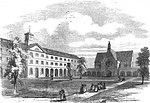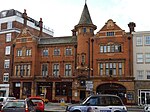Fulham Pottery

The Fulham Pottery was founded in Fulham, London, by John Dwight in 1672, at the junction of New King's Road and Burlington Road, Fulham, not far from Putney Bridge. Dwight is the earliest clearly documented maker of stoneware in England, although immigrant Dutch or German potters were probably active several decades before. By 1690 there was a rival stoneware operation in Fulham, run by the Dutch Elers brothers, who after a few years went off to become important early figures in transforming the Staffordshire pottery industry.In its first years it was a pioneering force in English pottery in several respects, in particular salt-glazed wares and figures. After Dwight's death in 1703 the pottery made less ambitious stonewares until a revival in the later 19th century. It operated on the same site until 1956, and then until at least the 1980s as a base for studio pottery to be fired. Today, all that remains of the original pottery is one large bottle kiln, "probably 19th-century", which is now a Grade II listed building.
Excerpt from the Wikipedia article Fulham Pottery (License: CC BY-SA 3.0, Authors, Images).Fulham Pottery
Burlington Road, London Parson's Green (London Borough of Hammersmith and Fulham)
Geographical coordinates (GPS) Address External links Nearby Places Show on map
Geographical coordinates (GPS)
| Latitude | Longitude |
|---|---|
| N 51.469819444444 ° | E -0.20883611111111 ° |
Address
Fulham Pottery
Burlington Road
SW6 4NH London, Parson's Green (London Borough of Hammersmith and Fulham)
England, United Kingdom
Open on Google Maps











